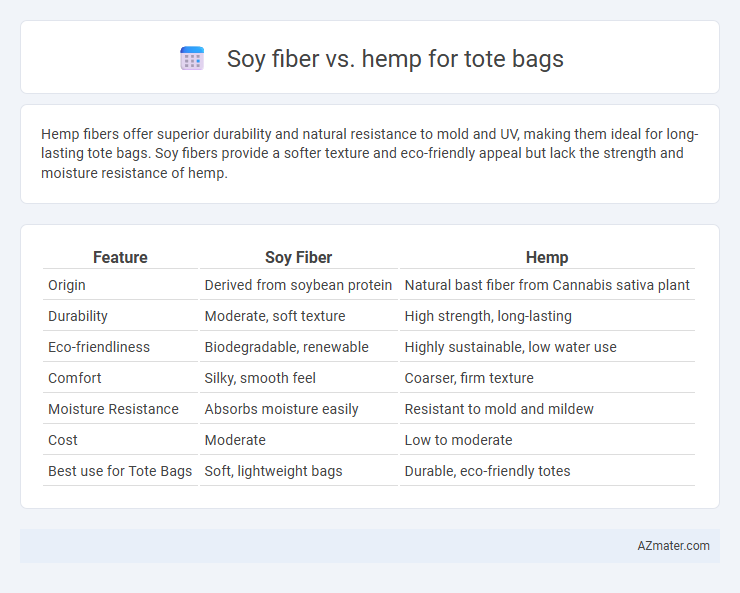Hemp fibers offer superior durability and natural resistance to mold and UV, making them ideal for long-lasting tote bags. Soy fibers provide a softer texture and eco-friendly appeal but lack the strength and moisture resistance of hemp.
Table of Comparison
| Feature | Soy Fiber | Hemp |
|---|---|---|
| Origin | Derived from soybean protein | Natural bast fiber from Cannabis sativa plant |
| Durability | Moderate, soft texture | High strength, long-lasting |
| Eco-friendliness | Biodegradable, renewable | Highly sustainable, low water use |
| Comfort | Silky, smooth feel | Coarser, firm texture |
| Moisture Resistance | Absorbs moisture easily | Resistant to mold and mildew |
| Cost | Moderate | Low to moderate |
| Best use for Tote Bags | Soft, lightweight bags | Durable, eco-friendly totes |
Introduction to Eco-Friendly Tote Bag Materials
Soy fiber offers a soft, biodegradable option for eco-friendly tote bags, known for its smooth texture and sustainability through the use of soy protein residues from tofu production. Hemp provides a durable, highly renewable material with natural resistance to pests and mold, resulting in long-lasting and sturdy tote bags with minimal environmental impact. Choosing between soy fiber and hemp depends on prioritizing softness and biodegradability versus strength and durability in sustainable bag production.
What is Soy Fiber?
Soy fiber is a natural textile made from soybean protein, known for its softness, durability, and eco-friendly properties. It offers a smooth texture and good moisture absorption, making it ideal for lightweight tote bags with a luxurious feel. Compared to hemp, soy fiber is more refined and comfortable but less rugged and less resistant to wear and tear.
What is Hemp Fiber?
Hemp fiber, derived from the stalks of the Cannabis sativa plant, is renowned for its strength, durability, and eco-friendly properties, making it an excellent choice for tote bags. Unlike soy fiber, which is a regenerated cellulose fiber from soy protein, hemp offers natural resistance to mold, UV rays, and wear, providing long-lasting utility. Hemp's biodegradable nature and minimal water requirements in cultivation further enhance its sustainability profile compared to many other natural fibers.
Sustainability Comparison: Soy vs Hemp
Soy fiber and hemp both offer sustainable options for tote bags, yet hemp outperforms soy fiber in terms of environmental impact due to its rapid growth cycle and minimal water requirements. Hemp cultivation absorbs more CO2 per acre and requires fewer pesticides and herbicides compared to soy, which often relies on intensive agriculture practices. While soy fiber is biodegradable and renewable, hemp's durability and lower resource consumption make it a superior choice for eco-friendly tote bags.
Production Process: Soy Fiber vs Hemp
The production process of soy fiber involves extracting protein from soybeans, which is then spun into fibers using environmentally friendly methods with minimal chemical use. Hemp fiber production requires harvesting the plant stalks, followed by retting to separate fibers, which is energy-efficient and uses fewer pesticides compared to conventional crops. Both fibers offer sustainable production, but hemp generally has a lower water footprint and faster growth cycle, making it a more eco-friendly choice for tote bags.
Durability and Strength of Each Material
Hemp fiber is renowned for its exceptional durability and tensile strength, making it highly resistant to wear and tear in tote bags. Soy fiber, while softer and more flexible, lacks the robustness of hemp and may show signs of stress under heavy loads or frequent use. Choosing hemp ensures a longer-lasting tote bag with superior structural integrity compared to soy fiber.
Biodegradability and Environmental Impact
Soy fiber exhibits excellent biodegradability, breaking down naturally within months without releasing harmful toxins, making it an eco-friendly option for tote bags. Hemp fiber, known for its durability and fast growth, also biodegrades efficiently while requiring fewer pesticides and less water compared to conventional cotton. Both fibers support sustainable tote bags, but hemp's lower environmental footprint during cultivation enhances its appeal for eco-conscious consumers.
Aesthetics and Texture Differences
Soy fiber offers a smooth, silky texture with a subtle sheen, lending tote bags a refined and elegant appearance that feels lightweight and soft to the touch. Hemp features a coarser, more rugged texture with a natural matte finish, providing tote bags a sturdy, rustic aesthetic that emphasizes durability and earthiness. The contrast between soy fiber's sleekness and hemp's tactile roughness caters to different style preferences, from sophisticated urban designs to eco-friendly, artisanal looks.
Cost and Market Availability
Soy fiber offers a lower-cost alternative to hemp, making it appealing for budget-conscious tote bag manufacturers, while hemp typically commands higher prices due to its durability and sustainability attributes. The market availability of soy fiber is expanding as agricultural byproducts are repurposed for textiles, but hemp remains more widely accessible due to established cultivation and processing infrastructure. Both fibers have growing demand in eco-friendly markets, though hemp's market presence benefits from stronger regulatory support and longer-standing consumer awareness.
Choosing the Best Fiber for Your Tote Bag
Soy fiber offers a soft texture and excellent dye absorption, making it ideal for vibrant, lightweight tote bags, while hemp provides superior durability, resistance to wear, and eco-friendly qualities suitable for heavy-duty use. Hemp fibers are naturally antimicrobial and UV resistant, enhancing the tote bag's longevity, whereas soy fiber, derived from soybean protein, supports sustainability but may require blending for added strength. Selecting the best fiber depends on prioritizing durability and environmental impact with hemp or softness and vivid color retention with soy fiber for your tote bag.

Infographic: Soy fiber vs Hemp for Tote bag
 azmater.com
azmater.com